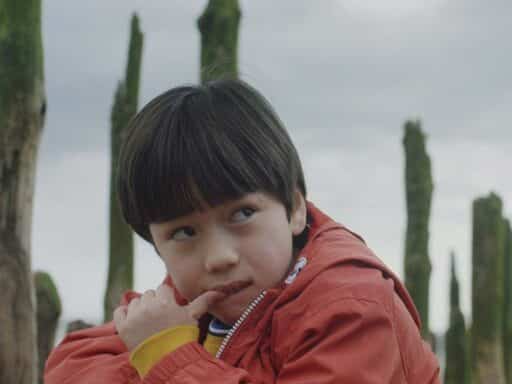The documentary evokes the perspective of people with autism.
There’s an axiom among critics that if a documentary would be more effective as a magazine article or book, then it shouldn’t also be a film. Movies aren’t just vehicles for messages or information delivery; they are immersive, sensory-rich experiences that let us submerge ourselves in someone else’s experience. If you’re going to make a movie, make it a movie.
The team behind The Reason I Jump understands this rule well, to the film’s great advantage. The documentary shares a title and draws inspiration from the 2007 bestselling nonfiction book by Naoki Higashida, who was just 13 when he, aided by his mother, wrote about his life as a nonverbal autistic person. The book was translated from Japanese to English in 2013 by Keiko Yoshida and her husband, the novelist David Mitchell.
In the book, Higashida describes what it is like to be him. The way his attention is attracted to details of an object, rather than the whole. The way memories and events of the past forcefully exist in the present. What it feels like to observe how others view him and treat him.
To adapt The Reason I Jump for the screen, director Jerry Rothwell opted not to simply replicate what’s in the text (a young boy, Jim Fujiwara, stands in for Higashida) and add some expert commentary, but to also immerse the audience in the experience of his subjects. So in the resulting film, we meet five people with autism from around the world. Amrit, who lives in India and does not speak, draws pictures of the people around her as a way of processing and communicating. Ben and Emma, two friends from Arlington, Virginia, communicate through letter boards. Joss, from the UK, is fascinated by the green boxes that power electrical circuits in his hometown and often talks about his old memories. And Jestina, in Sierra Leone, faces the additional difficulty of living in a culture in which superstitious elders believe her to be possessed by the devil.
/cdn.vox-cdn.com/uploads/chorus_asset/file/22223165/jump3.jpg) Kino Lorber
Kino LorberEach time we meet a new subject, The Reason I Jump avoids gawking, opting instead to gently invite us into the person’s world, as much as such an invitation can be extended by a filmmaker. Close-ups and carefully chosen angles aim to evoke the point of view of the autistic person, mixed with commentary from their families and friends. Throughout, Mitchell, whose son has autism, offers his own perspective, explaining how he felt when he encountered Higashida’s book — that it was “like an envoy from another world, whose culture, whose rules, whose reasons I don’t understand.”
The documentary version of The Reason I Jump tries to be that envoy to the audience. And while it’s tricky for a neurotypical person (such as myself) to know how well it succeeds — as Mitchell says, “neurotypicals are rubbish at understanding anything that is not neurotypical” — I do feel like it reaches its aims. I am fairly well acquainted with behaviors and other matters associated with autism, but I found myself surprised a number of times, and reminded of how little I truly understand the challenges our world presents to people with autism and their families, and the particular ways that autism teaches us to think differently about our world.
That’s not to say the film glamorizes or glorifies autism unduly. Instead, it exposes the way neurotypical attitudes toward what’s “expected” of human behavior, toward what’s considered “normal,” makes the lives of its subjects far from easy. Parents talk movingly about their love for their children (Joss’s parents are among the film’s executive producers) while also acknowledging their own feelings of inadequacy and fear. Amrit’s mother breaks down on camera, saying that “I don’t know how I fit into a mother’s role. I’ve tried to stop her from being herself.”
/cdn.vox-cdn.com/uploads/chorus_asset/file/22223184/jump2.jpg) Kino Lorber
Kino LorberBut it also provides a glimpse of hope. Ben and Emma have a close friendship fostered by their families since they were children. Through letter boards, which they tap at to spell out words, a process we see enacted throughout the film, they’ve been able to engage in education that was previously unavailable to them. Talking through the letter board about his previous educational circumstances, Ben says, “They have denied our civil rights” — something that’s clearly a serious problem for people with autism around the world. Jestina’s family has tried to address a lack of educational opportunities by helping to open one of the first schools for students with varying special needs in their region. The need is great.
The Reason I Jump points out the ways that centuries of misunderstanding about autism around the world hasn’t just hampered or even ruined the lives of people who have autism — those misunderstandings have also impoverished human culture. Eugenics foisted upon those seen through a patronizing lens by doctors and social engineers has sought to eradicate those who are labeled as having an “existence without life,” as the film exposes. But all that reveals is hubris on the part of those who consider themselves the authority on what it means to live a fulfilled life. A world in which someone who isn’t neurotypical can live successfully, understood and accepted by others, would be a better one. And films like The Reason I Jump, and the people profiled in it, are bringing the world closer to that point, a little at a time.
The Reason I Jump is available to digitally rent through virtual cinemas beginning January 8. Half of your rental fee supports the film and half supports the independent theater through which you purchase the rental. You can find a full listing at Kino Lorber’s website.
Author: Alissa Wilkinson
Read More



